
Ogcocephalidae is a family of anglerfish specifically adapted for a benthic lifestyle of crawling about on the seafloor. Ogcocephalid anglerfish are sometimes referred to as batfishes, deep-sea batfishes, handfishes, and seabats. They are found in tropical and subtropical oceans worldwide. They are mostly found at depths between 200 and 3,000 m, but have been recorded as deep as 4,000 m (13,000 ft). A few species live in much shallower coastal waters and, exceptionally, may enter river estuaries.

The spotfin frogfish, also known as the big-spot angler, coin-bearing frogfish, darkspot frogfish, ocellated angler, ocellated fringed fishing frog, opulent frogfish, spotfin angler or white-finger anglerfish, is a species ray-finned fish belonging to the family Antennariidae, the frogfishes. The spotfin frogfish is found in scattered locations the eastern Atlantic, Indian and western Pacific Oceans.

The ocellated frogfish is a species of marine ray-finned fish belonging to the family Antennariidae, the frogfishes. This fish is found in the Western Atlantic Ocean.

The pink frogmouth, or redeye, pink gaper or uniform gaper, is a species of marine ray-finned fish belonging to the family Chaunacidae, the sea toads. This species is found in the Atlantic Ocean.
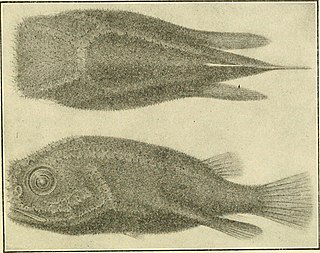
Coelophrys is a genus of marine ray-finned fishes belonging to the family Ogcocephalidae, the deep-sea batfishes or sea bats. The fishes in this genus are found in the western Pacific Ocean and the Indian Ocean.

Dibranchus is a genus of marine ray-finned fishes belonging to the family Ogcocephalidae, the deep sea batfishes. The fishes in this genus are widely distributed in the Atlantic, Indian and Pacific Oceans.
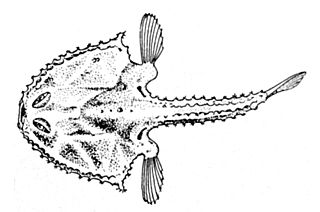
Halieutaea is a genus of marine ray-finned fishes belonging to the family Ogcocephalidae, the deep sea batfishes. These fishes are found in the Indian and Western Pacific Oceans.
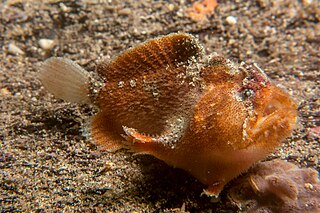
Echinophryne is a genus of marine ray-finned fishes belonging to the subfamily Histiophryninae in the family Antennariidae, the frogfishes. The fishes in this genus are endemic to the waters off Australia.
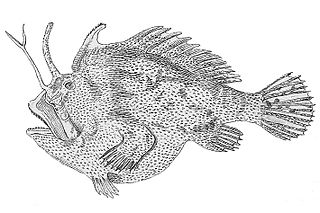
Kuiterichthys is a genus of marine ray-finned fishes belonging to the subfamily Histiophryninae in the family Antennariidae, the frogfishes. These fishes are endemic to Australia.
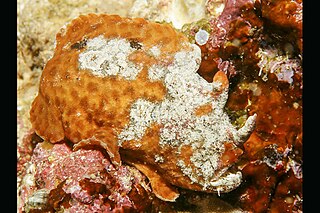
Phyllophryne is a monospecific genus of marine ray-finned fish belonging to the subfamily Histiophryninae in the family Antennariidae, the frogfishes. The only species in the genus is Phyllophryne scortea, the white-spotted anglerfish, smooth anglerfish or smooth frogfish, which is endemic to southern Australia.

The Atlantic batfish is a species of marine ray-finned fish belonging to the family Ogcocephalidae, the deep-sea batfishes. It is found in deep water in the Atlantic Ocean where it lives on the seabed, feeding on small invertebrates.
Abantennarius analis, the tailjet frogfish, tailjet anglerfish or dwarf frogfish, is a species of marine ray-finned fish belonging to the family Antennariidae, the frogfishes. This species is found in the eastern Indian Ocean and the western Pacific Ocean.
Abantennarius bermudensis, the island frogfish, is a species of marine ray-finned fish belonging to the family Antennariidae, the frogfishes. The island frogfish is found in the Western Atlantic Ocean.
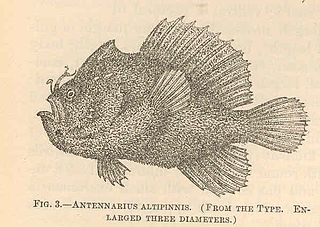
Abantennarius dorehensis, the New Guinean frogfish, bandtail frogfish, Dorei frogfish or white-spotted frogfish, is a species of marine ray-finned fish belonging to the family Antennariidae, the frogfishes. The New Guinean frogfish is found in the Indo-Pacific region.
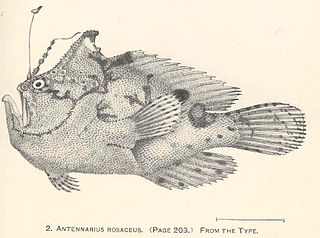
Abantennarius rosaceus, the rosy frogfish, rosy anglerfish, pink anglerfish or spiny tufted frogfish, is a species of marine ray-finned fish belonging to the family Antennariidae, the frogfishes. The rosy frogfish is found in the Indo-Pacific region.

Antennatus tuberosus, the tuberculate anglerfish, pygmy angler, pygmy frogfish or tuberculated frogfish, is a species of marine ray-finned fish belonging to the family Antennariidae, the frogfishes. This fish is found in the Indian and Pacific Oceans.

Echinophryne mitchellii, the long-spined frogfish, bristly frogfish, Mitchell's anglerfish, Mitchell's frogfish, prickly angler fish or spinycoat anglerfish, is a species of marine ray-finned fish belonging to the subfamily Histiophryninae in the family Antennariidae, the frogfishes. These fishes are endemic to the temperate waters of southern Australia.

Lophiocharon trisignatus, the spot-tail anglerfish, rough anglerfish or three-spot frogfish, is a species of marine ray-finned fish belonging to the subfamily Histiophryninae in the family Antennariidae, the frogfishes. This fish is found in the Indo-Pacific region.

Antennarius scaber, the splitlure frogfish or strated frogfish, is a species of marine ray-finned fish belonging to the family Antennariidae, the frogfishes. This species is found in the Western Atlantic Ocean and was previously considered to be a synonym of Antennarius striatus.

Chaunax suttkissi, the pale-cavity gaper, spotted frogmouth, spotted gaper or Sutkus sea toad, is a species of marine ray-finned fish belonging to the family Chaunacidae, the sea toads. This species is found in the Atlantic Ocean.

















